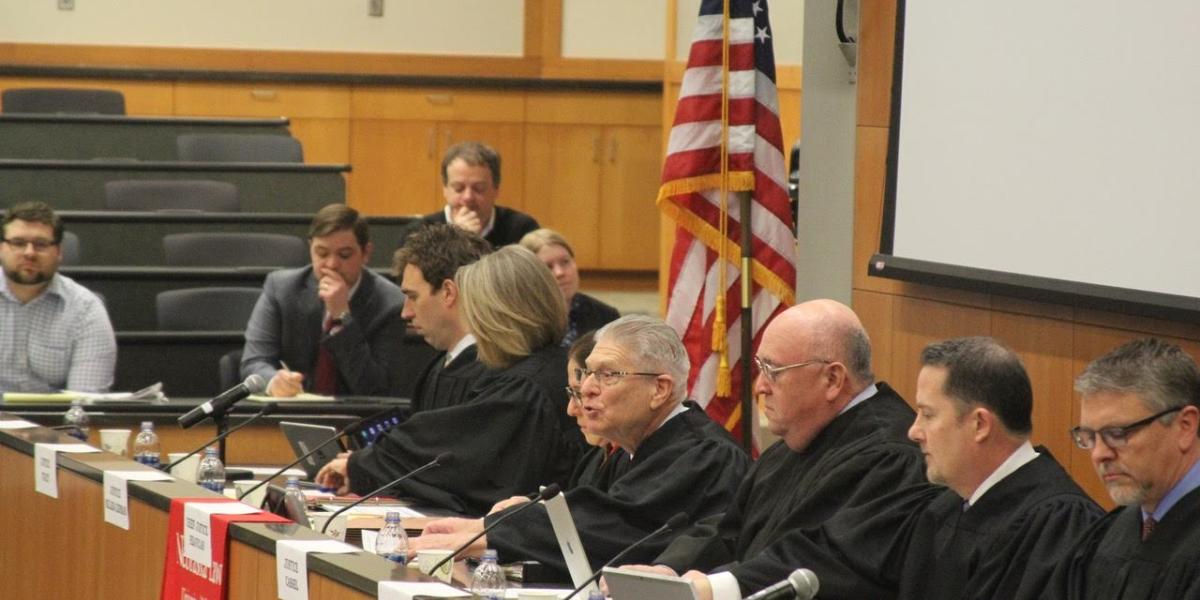Nebraska Supreme Court holds oral arguments at college
by Meghan Straub
Nebraska News Service
Future Nebraska lawyers have a chance this spring to see what practicing their craft actually looks like before the Nebraska Supreme Court.
On Feb. 28, the University of Nebraska College of Law hosted the Nebraska Supreme Court’s oral arguments, a tradition that has occurred annually for over 30 years.
With the goal of making the Court’s business accessible to students throughout the state, annual visits are also made to the Creighton University School of Law and select high schools. The arguments were also live-streamed on Nebraska Educational Television for students who were unable to attend.
“This event is incredibly important,” said Richard Moberly, dean of the Nebraska College of Law. “The students get to see law being practiced at the highest level.”
Chief Justice Mike Heavican and six associate justices entered a temporary “courtroom” with about 200 observers consisting of students and professors of law, and the oral arguments began.
College students and attendees were able to observe four court cases with a range in topics that were designed to demonstrate the variety of legal arguments seen in the court system on a daily basis.
“One of the primary goals of holding arguments at the law schools is to give students an opportunity to see and experience the appellate process first hand,” Justice Stephanie Stacy said.
Stacy said the video archive lets students and new lawyers develop their oral advocacy skills by watching how experienced lawyers present their cases and respond to questions from the court.
"It also allows everyone to see how justice is being administered in our appellate courts," Stacy said.
With provided case descriptions, case briefs and other resources, the students “have enough classes under their belt that they can dig into the arguments,” Moberly said.
Upon the completion of these cases, the justices allowed time for the students to ask questions. The topics discussed included the justices’ backgrounds, the number of cases they review each month and advice they have.
Assistant Dean Marc Pearce said the session is well-timed for first-year law students, as they are just beginning to learn about oral arguments in the college's legal research and writing course.
"This is a wonderful opportunity for our students to review case briefs and see first-hand how attorneys argue those briefs before the Court. In addition to the regular court proceedings, students also have the opportunity to ask questions of the Justices to learn about how they generally make their decisions, and what the Justices feel makes for a good oral argument," Pearce said.
While this event provides the students with educational opportunities, Heavican said it does the same for himself and his fellow justices. He also thanked those working at the law schools for hosting the event.
“We will see you in a courtroom later,” he said to the students.
As the commitment to making the business of law accessible to students continues, the Supreme Court will complete visits to Creighton and Boys Town in March.
Photo: Nebraska Supreme Court Chief Justice Mike Heavican addresses the crowd during the oral arguments hosted by the Nebraska College of Law Feb. 28, 2019.
About the Nebraska News Service
The Nebraska News Service is the state government news wire service provided by the University of Nebraska-Lincoln College of Journalism and Mass Communications. Our reporters cover a wide range of state government news, including the Nebraska Legislature, the governor's office, state agencies, decisions by Nebraska's Supreme Court, and other news stories as they arise. NNS provides news and information in the form of stories, photos and video. Located in Lincoln, the political heart of the state, we are able to provide our clients with powerful, relevant stories, straight from the source. In turn, our reporters get real-life experience and exposure to the news world. We put particular emphasis on providing content that is relevant to our clients and the communities they serve. Our current client list includes more than 100 newspapers throughout the state with a combined circulation exceeding 280,000, 16 radio stations and 6 television stations.

